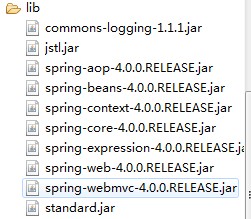框架搭建步骤:
1.首先,导入SpringMVC需要的jar架包。

2.添加Web.xml配置文件中关于SpringMVC的配置
<!--configure the setting of springmvcDispatcherServlet and configure the mapping-->
<servlet>
<servlet-name>springmvc</servlet-name>
<servlet-class>org.springframework.web.servlet.DispatcherServlet</servlet-class>
<init-param>
<param-name>contextConfigLocation</param-name>
<param-value>classpath:springmvc.xml</param-value>
</init-param>
<!-- <load-on-startup>1</load-on-startup> -->
</servlet>
<servlet-mapping>
<servlet-name>springmvc</servlet-name>
<url-pattern>/</url-pattern>
</servlet-mapping>
3.在src下添加springmvc.xml配置文件
<?xml version="1.0" encoding="UTF-8"?>
<beans xmlns="http://www.springframework.org/schema/beans"
xmlns:xsi="http://www.w3.org/2001/XMLSchema-instance"
xmlns:context="http://www.springframework.org/schema/context"
xmlns:aop="http://www.springframework.org/schema/aop"
xsi:schemaLocation="http://www.springframework.org/schema/beans http://www.springframework.org/schema/beans/spring-beans.xsd
http://www.springframework.org/schema/context http://www.springframework.org/schema/context/spring-context-4.0.xsd
http://www.springframework.org/schema/aop http://www.springframework.org/schema/aop/spring-aop-4.0.xsd">
<context:component-scan base-package="com.db"></context:component-scan>
<bean class="org.springframework.web.servlet.view.InternalResourceViewResolver">
<!-- 前缀 -->
<property name="prefix" value="/WEB-INF/user/"></property>
<!-- 后缀 -->
<property name="suffix" value=".jsp"></property>
</bean>
</beans>
4.在WEB-INF文件夹下创建名为jsp的文件夹,用来存放jsp视图。创建一个hello.jsp,在body中添加“Hello World”。
5.建立包及Controller,如下所示

6.编写Controller代码
@Controller
@RequestMapping("/mvc")
public class mvcController {
@RequestMapping("/hello")
public String hello(){
return "hello";
}
}
7.启动服务器,键入 http://localhost:8080/项目名/mvc/hello
二、配置解析
1.Dispatcherservlet
DispatcherServlet是前置控制器,配置在web.xml文件中的。拦截匹配的请求,Servlet拦截匹配规则要自已定义,把拦截下来的请求,依据相应的规则分发到目标Controller来处理,是配置spring MVC的第一步。
2.InternalResourceViewResolver
视图名称解析器
3.以上出现的注解
@Controller 负责注册一个bean 到spring 上下文中
@RequestMapping 注解为控制器指定可以处理哪些 URL 请求
三、SpringMVC常用注解
@Controller
负责注册一个bean 到spring 上下文中
@RequestMapping
注解为控制器指定可以处理哪些 URL 请求
@RequestBody
该注解用于读取Request请求的body部分数据,使用系统默认配置的HttpMessageConverter进行解析,然后把相应的数据绑定到要返回的对象上 ,再把HttpMessageConverter返回的对象数据绑定到 controller中方法的参数上
@ResponseBody
该注解用于将Controller的方法返回的对象,通过适当的HttpMessageConverter转换为指定格式后,写入到Response对象的body数据区
@ModelAttribute
在方法定义上使用 @ModelAttribute 注解:Spring MVC 在调用目标处理方法前,会先逐个调用在方法级上标注了@ModelAttribute 的方法
在方法的入参前使用 @ModelAttribute 注解:可以从隐含对象中获取隐含的模型数据中获取对象,再将请求参数 –绑定到对象中,再传入入参将方法入参对象添加到模型中
@RequestParam
在处理方法入参处使用 @RequestParam 可以把请求参 数传递给请求方法
@PathVariable
绑定 URL 占位符到入参
@ExceptionHandler
注解到方法上,出现异常时会执行该方法
@ControllerAdvice
使一个Contoller成为全局的异常处理类,类中用@ExceptionHandler方法注解的方法可以处理所有Controller发生的异常
四、自动匹配参数
//match automatically
@RequestMapping("/person")
public String toPerson(String name,double age){
System.out.println(name+" "+age);
return "hello";
}
五、自动装箱
1.编写一个Person实体类
package test.SpringMVC.model;
public class Person {
public String getName() {
return name;
}
public void setName(String name) {
this.name = name;
}
public int getAge() {
return age;
}
public void setAge(int age) {
this.age = age;
}
private String name;
private int age;
}
2.在Controller里编写方法
//boxing automatically
@RequestMapping("/person1")
public String toPerson(Person p){
System.out.println(p.getName()+" "+p.getAge());
return "hello";
}
六、使用InitBinder来处理Date类型的参数
//the parameter was converted in initBinder
@RequestMapping("/date")
public String date(Date date){
System.out.println(date);
return "hello";
}
//At the time of initialization,convert the type "String" to type "date"
@InitBinder
public void initBinder(ServletRequestDataBinder binder){
binder.registerCustomEditor(Date.class, new CustomDateEditor(new SimpleDateFormat("yyyy-MM-dd"),
true));
}
七、向前台页面传递参数
//pass the parameters to front-end
@RequestMapping("/show")
public String showPerson(Map<String,Object> map){
Person p =new Person();
map.put("p", p);
p.setAge(20);
p.setName("tom");
return "show";
}
八、使用Ajax调用
//pass the parameters to front-end using ajax
@RequestMapping("/getPerson")
public void getPerson(String name,PrintWriter pw){
pw.write("hello,"+name);
}
@RequestMapping("/name")
public String sayHello(){
return "name";
}
前台用下面的Jquery代码调用
$(function(){
$("#btn").click(function(){
$.post("mvc/getPerson",{name:$("#name").val()},function(data){
alert(data);
});
});
});
九、在Controller中使用redirect方式处理请求
//redirect
@RequestMapping("/redirect")
public String redirect(){
return "redirect:hello";
}
十、文件上传
1.需要导入两个jar包

2.在SpringMVC配置文件中加入
<!-- upload settings -->
<bean id="multipartResolver" class="org.springframework.web.multipart.commons.CommonsMultipartResolver">
<property name="maxUploadSize" value="102400000"></property>
</bean>
3.方法代码
@RequestMapping(value="/upload",method=RequestMethod.POST)
public String upload(HttpServletRequest req) throws Exception{
MultipartHttpServletRequest mreq = (MultipartHttpServletRequest)req;
MultipartFile file = mreq.getFile("file");
String fileName = file.getOriginalFilename();
SimpleDateFormat sdf = new SimpleDateFormat("yyyyMMddHHmmss");
FileOutputStream fos = new FileOutputStream(req.getSession().getServletContext().getRealPath("/")+
"upload/"+sdf.format(new Date())+fileName.substring(fileName.lastIndexOf('.')));
fos.write(file.getBytes());
fos.flush();
fos.close();
return "hello";
}
4.前台form表单
<form action="mvc/upload" method="post" enctype="multipart/form-data">
<input type="file" name="file"><br>
<input type="submit" value="submit">
</form>
十一、使用@RequestParam注解指定参数的name
@Controller
@RequestMapping("/test")
public class mvcController1 {
@RequestMapping(value="/param")
public String testRequestParam(@RequestParam(value="id") Integer id,
@RequestParam(value="name")String name){
System.out.println(id+" "+name);
return "/hello";
}
}
十二、REST风格的SringMVC(支持tomcat7.0以下版本)
1.RestController
package com.db.controller;
import java.util.Map;
import org.springframework.stereotype.Controller;
import org.springframework.web.bind.annotation.PathVariable;
import org.springframework.web.bind.annotation.RequestMapping;
import org.springframework.web.bind.annotation.RequestMethod;
import org.springframework.web.bind.annotation.ResponseBody;
import org.springframework.web.bind.annotation.RestController;
@RequestMapping("/spring")
@Controller
public class SpringMVC2 {
@RequestMapping("/delete/{id}")
public String delete(@PathVariable("id") Integer id) {
System.out.println("删除id是"+id+"的记录");
return "success";
}
@RequestMapping(value="/testRest/{id}",method=RequestMethod.GET)
public String testRest(@PathVariable("id") Integer id) {
System.out.println("获取id="+id+"的记录");
return "success";
}
@RequestMapping(value="/testRest",method=RequestMethod.POST)
public String testRest() {
System.out.println("新增,没有id");
return "success";
}
@RequestMapping(value="/testRest/{id}",method=RequestMethod.DELETE)
public String testRestDelete(@PathVariable("id") Integer id) {
System.out.println("删除id="+id+"的记录");
return "success";
}
@RequestMapping(value="/testRest/{id}",method=RequestMethod.PUT)
public String testRestPut(@PathVariable("id") Integer id) {
System.out.println("更新id="+id+"的记录");
return "success";
}
}
2.form表单发送put和delete请求
在web.xml中配置
<!-- configure the HiddenHttpMethodFilter,convert the post method to put or delete -->
<filter>
<filter-name>HiddenHttpMethodFilter</filter-name>
<filter-class>org.springframework.web.filter.HiddenHttpMethodFilter</filter-class>
</filter>
<filter-mapping>
<filter-name>HiddenHttpMethodFilter</filter-name>
<url-pattern>/*</url-pattern>
</filter-mapping>
在前台可以用以下代码产生请求
删除id等于1的记录
<form action="spring/testRest/1" method="post">
<input type="hidden" name="_method" value="delete"/>
<input type="submit" value="test delete"/>
</form>
<br><br>
更新id等于1的记录
<form action="spring/testRest/1" method="post">
<input type="hidden" name="_method" value="put"/>
<input type="submit" value="test put"/>
</form>
<br><br>
新增id等于1的记录
<form action="spring/testRest" method="post">
<input type="submit" value="test post"/>
</form>
<br><br>
得到id等于1的记录
<a href="spring/testRest/1">test Rest Get</a>
十三、返回json格式的字符串
1.导入以下jar包

2.方法代码
@Controller
@RequestMapping("/json")
public class jsonController {
@ResponseBody
@RequestMapping("/user")
public User get(){
User u = new User();
u.setId(1);
u.setName("jayjay");
u.setBirth(new Date());
return u;
}
}
十四、异常的处理
1.处理局部异常(Controller内)
@ExceptionHandler
public ModelAndView exceptionHandler(Exception ex){
ModelAndView mv = new ModelAndView("error");
mv.addObject("exception", ex);
System.out.println("in testExceptionHandler");
return mv;
}
@RequestMapping("/error")
public String error(){
int i = 5/0;
return "hello";
}
2.处理全局异常(所有Controller)
@ControllerAdvice
public class testControllerAdvice {
@ExceptionHandler
public ModelAndView exceptionHandler(Exception ex){
ModelAndView mv = new ModelAndView("error");
mv.addObject("exception", ex);
System.out.println("in testControllerAdvice");
return mv;
}
}
3.另一种处理全局异常的方法
在SpringMVC配置文件中配置
<!-- configure SimpleMappingExceptionResolver -->
<bean class="org.springframework.web.servlet.handler.SimpleMappingExceptionResolver">
<property name="exceptionMappings">
<props>
<prop key="java.lang.ArithmeticException">error</prop>
</props>
</property>
</bean>
SpringMVC详细运行流程图

SpringMVC运行原理
1. 客户端请求提交到DispatcherServlet
2. 由DispatcherServlet控制器查询一个或多个HandlerMapping,找到处理请求的Controller
3. DispatcherServlet将请求提交到Controller
4. Controller调用业务逻辑处理后,返回ModelAndView
5. DispatcherServlet查询一个或多个ViewResoler视图解析器,找到ModelAndView指定的视图
6. 视图负责将结果显示到客户端
SpringMVC与struts2的区别
1、springmvc基于方法开发的,struts2基于类开发的。springmvc将url和controller里的方法映射。映射成功后springmvc生成一个Handler对象,对象中只包括了一个method。方法执行结束,形参数据销毁。springmvc的controller开发类似web service开发。
2、springmvc可以进行单例开发,并且建议使用单例开发,struts2通过类的成员变量接收参数,无法使用单例,只能使用多例。
3、经过实际测试,struts2速度慢,在于使用struts标签,如果使用struts建议使用jstl。




 本文深入解析SpringMVC框架的搭建步骤、配置解析、常用注解及其应用场景,包括参数匹配、视图解析、异常处理、REST风格实现、JSON响应等核心功能。
本文深入解析SpringMVC框架的搭建步骤、配置解析、常用注解及其应用场景,包括参数匹配、视图解析、异常处理、REST风格实现、JSON响应等核心功能。
















 1029
1029

 被折叠的 条评论
为什么被折叠?
被折叠的 条评论
为什么被折叠?








